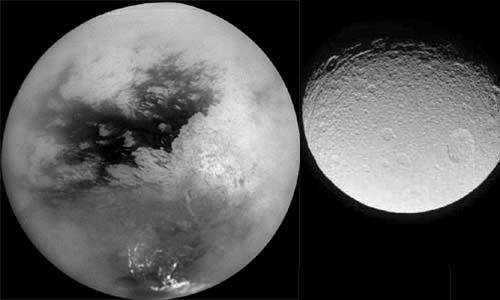Two more detailed photos of Saturn's moons and this time Titan and Thetis in photo attachments

In two new images of Saturn's moons, Titan and Tethys, which are considered to be the most detailed images obtained of these moons, you can see the sharp differences between the two - one nebulous and the other full of craters.
The spacecraft "Cassini" [Cassini] took the pictures of the mysterious moon Titan during its initial approach to it, which was on October 26 of this year. The mosaic image she made relies on nine images, taken from distances of approximately 650,000 km to 300,000 km from the face of the moon.
The photos can be found on the following websites:
http://saturn.jpl.nasa.gov
http://www.nasa.gov/cassini,
http://ciclops.org
The image consists of an aggregate that works to reduce the effect of the atmosphere and to sharpen the features of the surface. The image collection was designed so that only the illuminated surface and not the atmosphere around the edge of the moon can be seen. The sun was behind Cassini so that almost the entire lunar disk was illuminated. The clouds at the South Pole are visible at the bottom of the image.
Terrain features are particularly prominent near the center of the moon, and become more blurred towards the outer side of the moon, where the spacecraft had to photograph through more fog. The bright area on the right side of the image is called Xanadu Regio. Scientists debate a lot about the processes that created this bright area and its strange pattern. The lack of craters on Titan is a clear indication that it has a young surface. But despite this, nothing is known about Titan's surface activity; It could be tectonic, volcanic, or full of storms, there are many possibilities.
Two days after the dramatic approach to the icy Titan, "Cassini" took the images that later became a composite of the cratered Saturnian moon Tethys.
Probably in the picture, Thetis was photographed in his natural color. Three images were required to make this final color image. The accretion reveals a world saturated with craters, while many craters are located on the backs of older ones, implying that the moon is very ancient. At the top of the picture, in the transition area between day and night, you can also see canals.
Tethys is known to have a density very similar to that of water, indicating that it is composed mostly of water and ice. Its icy mysteries await Cassini's flyby in September 2005.
The images for the Tethys attachment were taken on October 28 of this year, from a distance of approximately 256,000 km from the surface of the satellite. In the picture you can see the lunar hemisphere, which moves against the direction of the moon's movement in its orbit.
Both images were taken using the wide-angle camera on board Cassini.
The article was first taken from: NASA/JPL News Release
